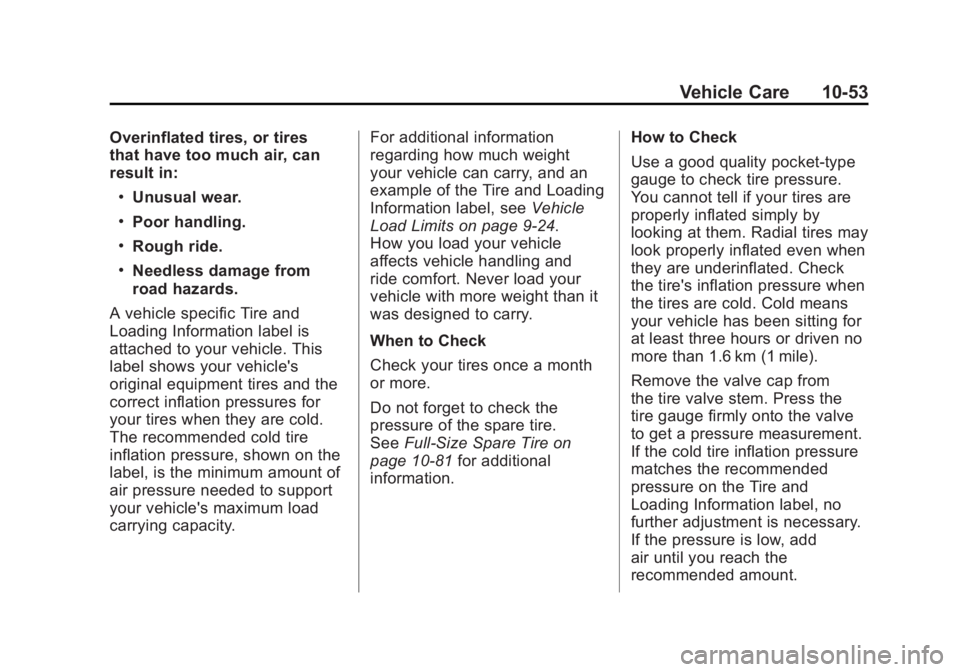load capacity CADILLAC ESCALADE ESV 2011 User Guide
[x] Cancel search | Manufacturer: CADILLAC, Model Year: 2011, Model line: ESCALADE ESV, Model: CADILLAC ESCALADE ESV 2011Pages: 548, PDF Size: 8.45 MB
Page 454 of 548

Black plate (52,1)Cadillac Escalade/Escalade ESV Owner Manual - 2011
10-52 Vehicle Care Treadwear Indicators :
Narrow
bands, sometimes called wear
bars, that show across the tread
of a tire when only 1.6 mm
(1/16 in) of tread remains. See
When It Is Time for New Tires
on page 10 ‑ 60 .
UTQGS (Uniform Tire Quality
Grading Standards) :
A tire
information system that provides
consumers with ratings for a
tire's traction, temperature,
and treadwear. Ratings
are determined by tire
manufacturers using
government testing procedures.
The ratings are molded into
the sidewall of the tire. See
Uniform Tire Quality Grading on
page 10 ‑ 63 . Vehicle Capacity Weight :
The number of designated
seating positions multiplied by
68 kg (150 lbs) plus the rated
cargo load. See Vehicle Load
Limits on page 9 ‑ 24 .
Vehicle Maximum Load on the
Tire :
Load on an individual tire
due to curb weight, accessory
weight, occupant weight, and
cargo weight.
Vehicle Placard :
A label
permanently attached to a
vehicle showing the vehicle
capacity weight and the
original equipment tire size
and recommended inflation
pressure. See “ Tire and Loading
Information Label ” under Vehicle
Load Limits on page 9 ‑ 24 .Tire Pressure If the vehicle is a hybrid, see
the hybrid supplement for more
information.
Tires need the correct amount
of air pressure to operate
effectively.
Notice: Neither tire
underinflation nor
overinflation is good.
Underinflated tires, or
tires that do not have
enough air, can result in: .
Tire overloading and
over-heating which
could lead to a blowout. .
Premature or
irregular wear. .
Poor handling. .
Reduced fuel economy.
Page 455 of 548

Black plate (53,1)Cadillac Escalade/Escalade ESV Owner Manual - 2011
Vehicle Care 10-53Overinflated tires, or tires
that have too much air, can
result in: .
Unusual wear. .
Poor handling. .
Rough ride. .
Needless damage from
road hazards.
A vehicle specific Tire and
Loading Information label is
attached to your vehicle. This
label shows your vehicle's
original equipment tires and the
correct inflation pressures for
your tires when they are cold.
The recommended cold tire
inflation pressure, shown on the
label, is the minimum amount of
air pressure needed to support
your vehicle's maximum load
carrying capacity. For additional information
regarding how much weight
your vehicle can carry, and an
example of the Tire and Loading
Information label, see Vehicle
Load Limits on page 9 ‑ 24 .
How you load your vehicle
affects vehicle handling and
ride comfort. Never load your
vehicle with more weight than it
was designed to carry.
When to Check
Check your tires once a month
or more.
Do not forget to check the
pressure of the spare tire.
See Full-Size Spare Tire on
page 10 ‑ 81 for additional
information. How to Check
Use a good quality pocket-type
gauge to check tire pressure.
You cannot tell if your tires are
properly inflated simply by
looking at them. Radial tires may
look properly inflated even when
they are underinflated. Check
the tire's inflation pressure when
the tires are cold. Cold means
your vehicle has been sitting for
at least three hours or driven no
more than 1.6 km (1 mile).
Remove the valve cap from
the tire valve stem. Press the
tire gauge firmly onto the valve
to get a pressure measurement.
If the cold tire inflation pressure
matches the recommended
pressure on the Tire and
Loading Information label, no
further adjustment is necessary.
If the pressure is low, add
air until you reach the
recommended amount.
Page 467 of 548

Black plate (65,1)Cadillac Escalade/Escalade ESV Owner Manual - 2011
Vehicle Care 10-65
Wheel Alignment and Tire
Balance The tires and wheels were aligned
and balanced at the factory to
provide the longest tire life and best
overall performance. Adjustments to
wheel alignment and tire balancing
will not be necessary on a regular
basis. However, check the
alignment if there is unusual tire
wear or if the vehicle is pulling to
one side or the other. If the vehicle
vibrates when driving on a smooth
road, the tires and wheels might
need to be rebalanced. See your
dealer for proper diagnosis.
Wheel Replacement Replace any wheel that is bent,
cracked, or badly rusted or
corroded. If wheel nuts keep
coming loose, the wheel, wheel
bolts, and wheel nuts should be
replaced. If the wheel leaks air,
replace it. Some aluminum wheels
can be repaired. See your dealer if
any of these conditions exist. Your dealer will know the kind of
wheel that is needed.
Each new wheel should have the
same load-carrying capacity,
diameter, width, offset, and be
mounted the same way as the
one it replaces.
Replace wheels, wheel bolts, wheel
nuts, or Tire Pressure Monitor
System (TPMS) sensors with new
GM original equipment parts.
{ WARNINGUsing the wrong replacement
wheels, wheel bolts, or wheel
nuts can be dangerous. It could
affect the braking and handling of
the vehicle. Tires can lose air,
and cause loss of control, causing
a crash. Always use the correct
wheel, wheel bolts, and wheel
nuts for replacement. Notice: The wrong wheel can
also cause problems with
bearing life, brake cooling,
speedometer or odometer
calibration, headlamp aim,
bumper height, vehicle ground
clearance, and tire or tire chain
clearance to the body and
chassis.
See If a Tire Goes Flat on
page 10 ‑ 66 for more information.
Used Replacement Wheels
{ WARNINGReplacing a wheel with a used
one is dangerous. How it has
been used or how far it has been
driven may be unknown. It could
fail suddenly and cause a crash.
When replacing wheels, use a
new GM original equipment
wheel.